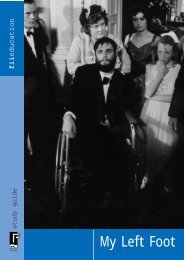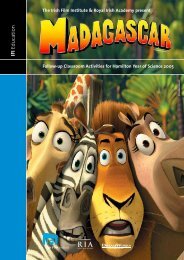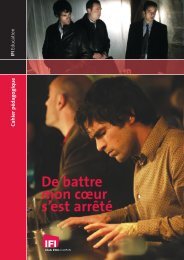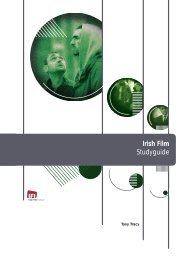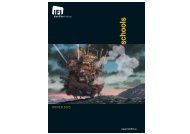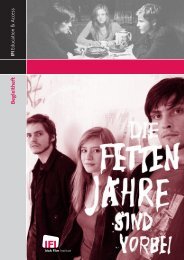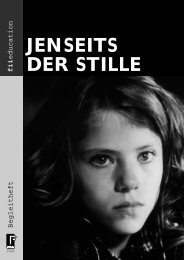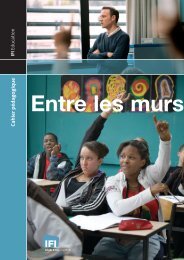McGahern On Film - Irish Film Institute
McGahern On Film - Irish Film Institute
McGahern On Film - Irish Film Institute
- No tags were found...
You also want an ePaper? Increase the reach of your titles
YUMPU automatically turns print PDFs into web optimized ePapers that Google loves.
Leitrim Cinemobilein association with the IRISH FILM ARCHIVE presents<strong>McGahern</strong> <strong>On</strong> <strong>Film</strong>Drumshanbo, Co Leitrim23 - 25 September 2005www.leitrimcinema.ie
The films, assembled for this event with our partners at the <strong>Irish</strong> <strong>Film</strong> Archive,represent a significant body of work in their own right, all the more so because theyears in which they were made were sparse years for <strong>Irish</strong> film-makers. The workdrew the finest of film-making talent, not least in the person of Kieran Hickeydirector of The Rockingham Shoot who is fondly remembered as one of the groundbreakingmakers of <strong>Irish</strong> television drama. His untimely death in 1993 cut short thiscontribution. <strong>On</strong> the big-screen, <strong>McGahern</strong> has found his chief exponent in arguablythe most natural directorial talent of his generation, Cathal Black, from whom thereis undoubtedly more to come.Untimely also describes the departure from the scene of screen talents such asDonal McCann, Pat Leavy and Tony Doyle who feature strongly in the work alongwith the best actors of their generation and indeed the next: watch out for anexcellent performance from Tom Murphy, star of last year’s <strong>Irish</strong> cinema hit Adamand Paul, playing the child lead in The Key and The Lost Hour.It is an honour for Leitrim Cinemobile to bring this work together. In addition to ourongoing work of bringing the widest range of cinema to the county which includesclose to 25 World Cinema titles annually presented regularly throughout the county,it is our hope that having raised the issue of the necessary if problematicrelationship of cinema and literature that we can continue this exploration in yearsto come.Our thanks to Sean Kielty whose passion and singular vision has driven thiscinemobile project and to John <strong>McGahern</strong> for the inspiration and generosity of spiritto let things happen.Johnny Gogan,Chair, Leitrim CinemobileThanksFurther thanks are of course due to Sunniva O'Flynn, Aoife Coughlan and Kaz O'Connell of the <strong>Irish</strong><strong>Film</strong> Archive, Bandit <strong>Film</strong>s, Leitrim County Council, The Arts Council, The Glens CentreManorhamilton, Red Eye Design, The Mayflower Ballroom Drumshanbo, Luke Gibbons, Jo Wheatleyand RTE, the film-makers; B.B.C N. Ireland, Parallel <strong>Film</strong>s, Hummingbird <strong>Film</strong>s, Harvest <strong>Film</strong>s, CathalBlack <strong>Film</strong>s, The Arts Council of Ireland/An Chomhairle Ealionn. Danny McLoughlin, CourtyardStudios, Ramada Hotel and Suites at Lough Allen, Rose McGovern and our main sponsor BelRainsafe.Leitrim CinemobileAdministrative OfficesCommunity and Enterprise Dept.Aras an Chontae, Carrick-on-Shannon, Co. LeitrimDriver Projectionist: Tommy AherneEvent Manager: Kate MacCarthyPublicity: Colm FarrellFor further information contact colm_farrell@hotmail.comwww.leitrimcinema.ieprogramme information 086-8221139 or 086-1569172Bookings 087-9104532Ramada Hotel and Suites 071-9640100Board of Directors: Lelia Doolan, Joseph Gilhooly (Company Secretary), Johnny Gogan (Chair), GerryKelly, Paddy MacDonald, Kathleen McCaffrey, Sunniva O'FlynnFor those looking at public transport options there are regular <strong>Irish</strong> Rail and Bus Services to nearbyCarrick-on-Shannon. The Festival will be happy to assist with connections to and from Drumshanbo.The GlensCentreProject supported by theEU Programmefor Peace and Reconciliation
The Leitrim CinemobileIt is perhaps ironic that one ofthe country's most ambitiousventures into municipal cinemashould occur in the country'smost rural county. The brainchildof Leitrim-man Sean Kielty,Leitrim Cinemobile - AislingGheal - raised its start-up financethrough a country-widecompetition to commemorate the1998 centenary of LocalGovernment in Ireland.In June 2001 the cinema commenced a weekly service to the county's main townsof Ballinamore, Drumshanbo, Manorhamilton and Mohill. With the closure of thecounty's last remaining single-screen cinema - Carrick-on-Shannon's GaietyCinema in 2004 - the service was extended to the county town.<strong>On</strong>e of the most successful strands for thecinema is its Autumn - Spring seasons ofWorld Cinema, organised in conjunctionwith Manorhamilton's Glens Centre andCarrick-on-Shannon <strong>Film</strong> Society. ThisAutumn will see this service extended toDrumshanbo, Sunday nights. In addition,the cinema also provides a service tofestivals, schools, hospitals, community andaccess groups. The most ambitious of theseevents has been the participation in the July2005 Earagail Arts Festival in Donegal forwhich the cinema programmed a line up of<strong>Irish</strong> films with a particular Donegal appeal.The cinema seats one hundred peoplecomfortably, has full disability access and isoperated by long-standing driverprojectionistTommy Aherne. State-of-theart35mm projection is combined with DVDand video. The cinema is funded by LeitrimCounty Council which has been providingan important lead to local authoritiesnationwide who are increasingly beingencouraged by film promotion bodies suchas The Arts Council to get involved inCultural or World Cinema provision.
Korea 1996 80 minsProduction Company: Cathal Black <strong>Film</strong>s/Black Star <strong>Film</strong>sDirector: Cathal BlackProducer: Darryl CollinsScreenplay: Joe O'ByrneAdapted from the (3 page) short story of the same name, Korea is a seething feature drama whichtells the story of a young man and his father who make their living fishing for eels in the still waters ofthe rural lakelands. Upon finding that the fishing laws are soon to be changed, the father decides it'stime for the son to move to America. Having long wanted to leave home, the son is now uncertain,his doubts reinforced by his developing relationship with a local girl whose own family have paid theprice of emigration to America.<strong>Film</strong>ed in Cavan and the Dromahair area of Leitrim, Korea received a successful cinema release inIreland on its release and secured a number of prestigious awards including the Audience Award atSeattle and the Asta Nielsen Award at Copenhagen. Donal Donnelly captures the lead perfectly asthe troubled father who rules the roost, but appears as a remarkable non-entity in the outside world.The young leads, Andrew Scott and Fiona Molony, rightfully deserve their plaudits under the tutelageof one of the country's most accomplished directors of actors for the screen.Cast: John Doyle Donal Donnelly Eamon Doyle Andrew Scott Una MoranFiona Molony Ben Moran Vass Anderson Mrs. Moran Eileen WardMick Farrell Pat Fitzpatrick Barman Christopher Callery Mrs. MaguireSadie Maguire Postman Peter McNamee Dr. Whelan Gus WardLuke Moran Stephen Holland Mary Doyle Siubhan Dooney Priest Bill HickeyAmerican attache Cathal Farrelly Altar boy 1 Gary ReilyAltar boy 2 Charles McGuinness Veterans Franci Smith, Dan Moynihan,Mick O'Brien Sean Nos Singer Catriona Canavan Farmer 1 Tommy McArdleFarmer 2 Hugh O'Brien Ticket Agent Jim WilliamsonESB speaker Micheal Thornton Accordion Player Micheal O'BrienExecution Boy David Walsh Older Prisoner Maurice Keogh British soldier 1Marcus Cunihan British Soldier 2 John D'Alton Fisherman 1 Nigel RoffeFisherman 2 Sean McIntyre Ice digger Brian Reilly Truckman Sean Donnelly
Wheels 1976 21 minsProduction Company: The Arts Council of IrelandDirector: Cathal BlackProducer: Cathal BlackCathal Black's debut short film, shot by future director in his own right Joe Comerford, is anadaptation of the Nightlines short story of the same title. It tells the story of a midlands small farmer'sson who returns to his birthplace from the city. His return is fraught with frustrations and bittermemories. His father remains hostile towards him but his stepmother is sympathetic. His return to thecity is done so with a degree of relief, but a sense of frustration at being unable to move beyond theconfined life he has made for himself.Narrator/Son Brendan Ellis Lightfoot Paul Bennett Labourer Tom JordanFather Michael Duffy Rose Maura Keeley Priest Alec Doran Porters Don Foley,Peter Caffrey, Paul Britton, Johnny Murphy, Con Weber, Grainne Weber LorchhainO Treasaigh"At the time I thought that <strong>McGahern</strong>’s ‘The Dark’ was a very revealing and original work. I thought thatthere was a dark heart to the country that wasn’t being expressed but <strong>McGahern</strong> seemed to bring thisout. The film was about your parents aspirations for you not necessarily being your own and about yourparents wanting to become children again. The wheels had turned full circle and now the youngergeneration had to look after their parents as a reward for having brought them up. The son regrets thisand disappears into the twilight world of the city. <strong>McGahern</strong>’s writing at this time was very nihilistic,especially the short stories in ‘Nightlines’ (which also contains 'Korea'). This is to me the best writing hehas ever done. Wheels was close to a lot of what I was going through in my personal life, particularlywhen, much to my father’s disgust, I left RTE for the insecurity of film-making."Cathal Black in interview with Vincent Browne for <strong>Film</strong> West,1996
Amongst Women 19984-Part SerialProduction Company: Parallel <strong>Film</strong>s for BBC N. Ireland,RTE and The <strong>Irish</strong> <strong>Film</strong> Board/An Bord Scannan na HEireannDirector: Tom CairnsProducers: Jonathan Curling, Colin TuckerScreenwriter: Adrian Hodges"As he weakened, Moran became afraid of his daughters". Thus begins the story of the War ofIndependence veteran Michael Moran and his relationship in latter life with his off-spring. Theadaptation for television proved to be one of the last major screen appearances of Tony Doyle in thecommanding central role.In Episode 1, Moran is presented as a man who tries to put right in his family what he thinks iswrong with the world. His children struggle to live up to his expectations.Episode 2 sees Maggie re-united with Luke in London where she meets her first love. Back at GreatMeadows Moran's other daughters confront their futures and begin to test the bonds of love andduty.Episode 3 features young Michael's infatuation with Nell Morahan and his developing reaction to thedominance of his father. Whilst Michael strikes out for freedom, Luke's star is rising, Sheila has mether match and Maggie is heading for married life.In the Final Episode, the occasion of Sheila's wedding offers a last chance for Luke and Moran to bereconciled. For Moran's daughters, his decline reminds them that they were never able to leave him.Cast: Tony Doyle, Ger Ryan, Susan Lynch, Geraldine O'Rawe, Anne Marie Duff,Brian F. O'Byrne, Demian McAdamEpisodes 1 and 2 will be screened together as will Episodes 3 and 4
The Lost Hour 1982TV Drama 50 minsProduction Company: RTEDirector: Sean CotterProducer: Sean CotterScreenplay: Carlo GeblerAdapted from The Leavetaking, the story concerns ayoung boy's experience of his mother's illness anddeath from cancer in 1950s rural Ireland as well ashis relationship with his father, Sergeant Moran.Cast: Sergeant Moran Donal Moran Kate Moran Kate Binchy Patrick Moran Tom MurphyMrs Rooney Eibhlin Ni Mhurchu Michael Rooney Geoffrey Golden The Specialist Cecil BarrorYoung Nurse Catherine Byrne Guard Mullins Patrick Layde Mrs Mullins Sheila FlittonBridget Aine Ni Mhuiri Mrs Flynn Maire Hastings Maggie Gabrielle KeenanNed Breandan O Duill Ned's Helper Paddy Long Priest Seamus FordeFirst Fisherman Larry Murphy Second Fisherman Gerry O'BrienThe Key 1983TV Drama 47 minsProduction Company: RTEDirector: Tony BarryProducer: Tony BarryScreenplay: Carlo GeblerWith the re-casting of Sergeant Moran with DonalMcAnn and Tom Murphy's reappearance as PatrickMoran, this is a sequel to The Lost Hour and isbased on the short story The Bomb Box. While set inthe period after the death of wife and mother itdisplays a beguiling humour, most of it at theexpense of Sergeant Moran, reinforced by a lightnessof touch in the direction.Cast: Sergeant Moran Donal McCann Patrick Tom Murphy Garda Bannon Darragh O'MalleyDr. Neary Robert Carrickford Mrs. Ryan Pat Leavy Mrs. Wilson Beryl FaganThe existence of these two films was not known to The <strong>Irish</strong> <strong>Film</strong> Archive until, after a tip-off from LukeGibbons, an enquiry to Jo Wheatley in the RTE <strong>Film</strong> Library confirmed their existence."I left the National <strong>Film</strong> and Television School, Beaconsfield in 1979. The first job I got was adaptingthree <strong>McGahern</strong> pieces for RTE. I did the three but for some mysterious reason only two were made. Iliked <strong>McGahern</strong>'s prose hugely then and have seen no reason since to revise my opinions. His writingwas and is clean and clear, lucid, sparse, direct and always emotionally honest. Turning <strong>McGahern</strong>'sprose into television was a pleasure: good work may frustrate the adaptor because in the process oftranslation from the page to the screen things must be lost, but it was hardly onerous. The work fizzedand crackled and was full of energy and all I had to do was to re-imagine what already existed in a newvisual form. It was a delightful introduction to my professional working life as a writer".Carlo Gebler
The Rockingham Shoot 1987 59 minsProduction Company: BBC N. IrelandDirector: Kieran HickeyProducer: Danny BoyleScreenplay: John <strong>McGahern</strong>"Pheasants for the peasants" declares the film'sprotagonist Aidan O’Reilly to the pragmatic localgardai as they receive their annual gift from The BigHouse. Scripted as an original work for screen byJohn <strong>McGahern</strong>, this one-off tv drama - made byBBC Northern Ireland for the channel's ScreenplaySeries - is set in rural Ireland in the 1950s. Reilly isan intensely nationalistic teacher (played by BoscoHogan) with a deep loathing for British society, aloathing that explodes into violence when he learnsthat some of his pupils have skipped school to workat Rockingham for a pheasant shoot at which theBritish ambassador is a guest.The film was directed by the late Kieran Hickey, one of the major <strong>Irish</strong> tv dramatists. Hickey's earlierwork included the ground-breaking Exposure and A Criminal Conversation. The Rockingham Shootwas produced by Danny Boyle, then in-house producer with BBC Northern Ireland, who went on todirect the acclaimed Trainspotting.Cast: Aidan O'Reilly Bosco Hogan The Canon Niall Tobin Mrs O’Reilly Marie KeanThe Magician Tony Rohr The Sergeant Oliver Maguire John Reilly Ian mcElhinneyMary Armstrong Hilary Reynolds Guard Mullins John Olohan Guard Casey Gerard McSorleySwallows 2000 20 minsProduction Company: A Boy Named Sue Productionsin association with Dun Laoghaire <strong>Institute</strong> of Art, Design and TechnologyDirector: Michael O'ConnellProducer: Michael McCauleyScreenplay: Michael O'Connell<strong>Film</strong>ed in black and white and made as a student piece this short film deals with an isolated ruralGarda who is reminded of his passion for music when he meets a violin-playing Detective. Thisencounter throws the tedium of the Garda's existence into sharp relief.Cast: Sergeant Sean Colgan Surveyor Simon O'Gorman Bea Una Minto
A Private World 2005 52minsProduction Company: Hummingbird <strong>Film</strong>s/Harvest <strong>Film</strong>s for RTEDirector: Pat CollinsProducers: Tina Morgan, Philip KingIn this minimalist and intimate documentary, John <strong>McGahern</strong> speaks of the family events that inspiredhis 1974 novel The Leavetaking and brings us into the landscape of the County Leitrim farm where helives and writes. "You need to have a good, boring life in which nothing much happens except what'sgoing on in your head. You want no excitements..." The film includes archive footage from the 1960s(more swinging times perhaps) when the writer began to be published and is enriched by theobservant cinematography of Donal Gilligan. In one of the film’s most unusual moments we step out ofthe Leitrim backwoods into a Tokyo subway, the writer looking like he might have just popped out for amessage.John <strong>McGahern</strong>, Private WorldI like a thing that Chekhov said: “When a writer takes a pen into his hand he accuses himself ofunanswerable egotism and all he can do with decency after that is to bow!” I also think that the onlydifference between the writer and the reader is that each of us has a private world which others cannotsee and that it’s with that private world that we all read. It’s a spiritual, private world. And the onlydifference between the writer and the reader is that he (the writer) has the knack or talent to be able todramatise that private world and turn it into words. But it’s the same private world that each of uspossesses. Joyce once described the piano as a coffin of music and I see the book as a coffin ofwords. That book, in fact, doesn’t live again until it finds a reader and you get as many versions of thebook as the number of readers it finds.From Studies an <strong>Irish</strong> Quarterly review 2001
Mythic Patterns by Brian LeydenThis appreciation of works for the screen written by or based on the stories of John <strong>McGahern</strong>is as much a means of making innovative use of Leitirm’s mobile cinema, the Aisling Gheal, asit is a celebration of the writer’s contribution to <strong>Irish</strong> film and television. Although the enterpriseis a timely and heartfelt tribute illuminating another facet of the work of an internationallyrenowned writer who chooses to live in Foxfield, Co. Leitrim, there is the intention also to helpconsolidate the future of what is currently the only dedicated cinema operating in the county. 1In this respect, by combining genuinely fervent with underlying economic motives, theoccasion is in keeping with that time-honoured marriage between enjoyment and commerce,wholesome fun and filthy lucre, the film industry – a business from which John <strong>McGahern</strong> has,for the most part, kept his prosecraft at a careful and patrician remove.Yet the themes that inform the writer’s work are in many ways cinematic. Reviewingthe recent <strong>Irish</strong> University Review Special Issue: John <strong>McGahern</strong>, 2 Liam Harte notes theconstants of his fiction across five decades have been ‘the mythic patterning of mundaneexperience, the revelation of the emblematic through the particular’, 3 – each of <strong>McGahern</strong>’sworks executed within a small but universally knowable world: precisely the qualities that makegreat cinema.Now it’s hardly possible to mention mythic patterning and cinema in the one breathwithout your next utterance being the name, Joseph Campbell. Campbell, an Americanacademic who died in 1987, was an authority on world mythology whose guiding idea was the‘commonality of themes in world myths pointing to a constant requirement in the humanpsyche for a centring in terms of deep principles’. 4According to Campbell, what each one of us is looking for is not the meaning of life(another constant in the work of <strong>McGahern</strong>) but the ‘experience of being alive’. And if dream isa personal experience of the deeper grounds of being, then myth is the society’s dream. Myth,therefore, connects us with the mystery that we are in a manner that brings us into harmonywith the concerns of our society.However, it is Campbell’s belief that the ancient mythical symbols, figures, themystery tales, the rites of instruction, initiation and transformation have lost their force so thatnowadays ‘there is no such society anymore as the gods once supported’. 5 Enlightenmentideals have usurped the relevance and efficacy of mythic story telling in practically all but onedomain. It is only in the cinema, where screenwriters and directors have adopted Campbell’stheories wholesale, that mass audiences still share and feel primordially moved by whatamounts to the bedrock myth representing the most elemental human response to the riddle oflife: the journey of the hero.The hero’s journey has many and complex manifestations and ramifications, but inessence it is the quest of the individual to overcome the dark passions thwarting him or herfrom coming to maturity. The individual is driven to confront and transcend his or herlimitations by mastering the irrational and darker impulses in their nature and by acquiringgreater resources of character to face down fear and live life to its fullest potential. In morematter of fact terms, this is the hard road to becoming oneself, and it is a road on which John<strong>McGahern</strong>’s characters in his stories and screen adaptations often stumble or becomeenchained along the way.
To put these abstract notions in more concrete terms I recall how in mid-May 2004, I wasworking on a script for a radio documentary about the closing of the last of the original singlescreencinemas in County Leitrim, 6 when I became preoccupied with the question of whatmade going to the cinema so enjoyable? Even the most dedicated cinemagoers found it hardto explain precisely why they loved ‘the pictures’, the flicks.Turning to my own experience of living in the rural hinterlands of Leitrim andRoscommon as a teenager I remembered the awful psychological and physical isolation –mentally and geographically I was occupying <strong>McGahern</strong> territory, albeit without being familiarwith his work, owing to it being banned at first and then later dismissed locally as the work of‘a pervert’ who having written some caustic home truths about the place he was from, I wastold, he had ‘let people down’.Growing up in a small community at that time, the biggest gathering of young peopleoutside school all week happened after mass on Sunday. And for the rest of the time I sweatedmy schooldays away in a brutalised and clueless daze, sucking on the top of my biro forinspiration like it was the salmon of knowledge, and still having my hands blistered with slapsfrom the sally rod or the sharp edge of a two-foot wooden ruler.Against this spirit-numbing existence the deep, dark well of the cinema auditoriumwas like entering my true church. The curtains rolled back and I experienced a quickening ofexpectations as the lights dimmed and the projector beam infused the dark like a cheap andpotent, gut-level tonic for loneliness and boredom: a luminous elixir for being at a loose endand craving entertainment. And perhaps that’s what going to see a film is and ever should be:happy diversion.This thought is reinforced by my earliest cinema memory of the parish priest inArigna, Fr. Cummins, who organised a bus to bring a bunch of neighbours, my mother and meto the pictures as an Easter treat (or duty) to see an edifying Biblical epic. Falling short of thespiritually improving impact the film was expected to have on me, my head began to droopabout the same time the apostles nodded off on Jesus in the garden of Gethsemane, and Iwas carried snoring and crusty-eyed with sleep from “The Greatest Story Ever Told”.My next trip to the cinema was to see agent 007, reassured by the neighbour who’dgiven me a lift that the new James Bond film was ‘a humdinger.’And sure enough, when James Bond strode on screen he took aim and fired animaginary bullet at the onlooker that pierced my imagination. From the opening sequence I washooked on the sham heroics of the dashing, larger than life screen hero, with his gadgets andglib remarks; able to rescue dangerous situations in unexpected ways, he was impossiblyproficient in everything yet he too possessed shades of the born cinema lover’s obsessive andsolitary instincts.Utter hokum at one level, the film brought home to me the possibility that I might alsolive heroically, love passionately and if called for, die well. Though these noble ideals didn’tstop me from rushing out the door at the end of the film before the fluttering tricolour appearedand everyone had to stand for the National Anthem.Nonetheless, the silver screen struck me as having the quality of a window on theworld; when the velvet curtains opened life and colour flooded in. And going back further intime, it’s possible that the enormous popularity of cinema in Ireland in the mid 1950s 7 not onlyinflamed and groomed a new level of romantic courtship and sophistication within thepopulation, it made <strong>Irish</strong> audiences painfully aware of the contrast between their frugalexistence and lives of infinitely more glamour and opportunity lived by the screen characters.Although it may be more realistic to believe that if economic circumstances had been better athome people would have remained in Ireland and worked here for a proper wage regardless ofmovie portrayals of impossibly lavish and sophisticated lifestyles abroad.
And there is something closer to the truth of what I felt as a young cinemagoer in the notionexpressed by Norman Mailer that ‘it’s as if film has an existence within the brain which may becomparable to memory and the dream’. 8 Exploring this idea further, Mailer goes on to suggestthat, ‘Quintessence of the elusive nature of film, the movie star is like a guide to bring usthrough the adventures of a half-conscious dream. It is even possible the movie star givesfocus to themes of the imagination so large, so romantic, and daring that they might neverencounter reality. How can an adolescent,’ Mailer continues, ‘have any real idea whether he willever have sex with a beautiful woman or fight for his life.’ Such events are so grand they maytake years of psychic preparation’. 9 And what Mailer is suggesting finally is the possibility thatthe dream life of the film exists not only to ‘provide escape but to prepare the psyche’ forremarkable moments which most likely will never come.Wherever the truth rests, the inescapable mythical patterning of life-experienceoperates on a spectrum ranging from the harmless fairytale to silver screen heroics to Freudiandream interpretation to full-scale religious doctrine. <strong>McGahern</strong>, who is acclaimed for thebareness of his prose style is a mythic pattern maker too, though he works at the most subtle,spare and ‘existential’ end of the mythical continuum, and pursues his themes with adedication as ‘implacable’ as a small town guard out to get you. Or to put it another way,John <strong>McGahern</strong> uses his pen like a Hilti gun; what he nails stays nailed.Often in his work there is a central figure whose determination to do what is rightblinds her, or mostly him, to the oppressive and brutal hurt caused by actions motivated bywhat are perceived as good or at least moral intentions. And <strong>McGahern</strong> is unsparing in hisexposure of human weakness, foibles and unintentional or deliberate wrong-headedness.Another of his major themes is power: power as a lurking threat, and power lost by its exercise– often through an irrational eruption of violence of feeling or actual physical violence. Butthere is too a constant yearning. The moments of greatest intensity and eloquence in his workhappen where the greatest effort is made by one or other of his characters to open their heartsto the transcendental.Yet at the very moment when revelation, or transfiguration even, is closest – less thana lover’s heartbeat or the next tick of a wristwatch regulator away – this is the very momentwhen the mystery eludes realisation. Stubbornly refusing the hocus-pocus and unsubstantiatedconsolations of institutionalised religion, and dismissing too the self-aware mimicking ofacceptable social mores and pieties of more pragmatic and crafty natures conforming towhat’s expected of them in order to suit their own ends (an unfailing source of black humour in<strong>McGahern</strong>’s work), his heroes are not equipped to embrace the transcendental alone withoutprops, and neither have they the capacity to go beyond the bounds of what would beconsidered socially acceptable behaviour within a narrowly provincial society founded on smallfarming, mass-going and decent inclinations.More painful still is the fact that having made the effort to open their hearts, only tobe abandoned on the cusp of the revivifying mothering embrace of the transcendental, hisheroes are left all the more bereft – as when the narrator at the end of the short story GoldWatch says: “I stood in that moonlit silence as if waiting for some word or truth, but nonecame, none ever came; and I grew amused at that part of myself that still expected something,standing like a fool out there in all the moonlit silence…” 10
Given how often his narrators find that life has no meaning other than what is,‘increasing or diminishing as it changes’, 11 it may seem that this delving into mythicalpatterning and the age-old hero’s journey is too grandiose to apply to work as locally rootedand earthy as <strong>McGahern</strong>’s, or the existing offshoot screen adaptations of his stories in:Wheels, The Lost Hour, Swallows, The Key, Korea, and Amongst Women, or even his ownscreenplay specifically written for television, The Rockingham Shoot.But in Korea, for example, I think straight away of that moment where a coffin drapedin the Stars and Stripes is ferried out onto an <strong>Irish</strong> lake for an island burial, a scenecompressing serene natural beauty, old blood feuds, trans-Atlantic politics, lost dreams, love,death and grief and even an <strong>Irish</strong>-style Greek Chorus offering wry commentary; Cathal Blackhas rendered on film a set-piece so profoundly lyrical and timelessly cinematic that it is imbuedwith that boundless power of the transcendental.And there are many other powerfully moving and multiply layered moments andscenes in <strong>McGahern</strong>’s work, in both his writing and the screen adaptations of his stories, eachproviding what his narrators so often yearn for but miss by a hair’s breadth: those imaginativeawakenings that summon us to full and openhearted human maturity.Notes:1. In the Golden Age of <strong>Irish</strong> cinema in the mid-nineteen fifties there were five cinemas in County Leitrim: the Gaietyin Carrick-on-Shannon, The Lyric in Ballinamore, The Castle in Manorhamilton, The Ritz in Mohill (with parking forbicycles) and The Roxy in Drumshanbo, (Billy Gilligan, ‘Carrick-on-Shannon’s Cinema Paradisio’, in Carrick-on-Shannon Remembered Vol. 1, Ck-on-Shannon and District Historical Society, 1998.2. John Brannigan (ed., publisher) <strong>Irish</strong> University Review Special Issue: John <strong>McGahern</strong>, 2005.3. <strong>Irish</strong> Times, Weekend Review, Sat July 9th 2005.4. Joseph Campbell with Bill Moyers, The Power of Myth, Doubleday, 1988, p.xvi.5.Joseph Campbell, The Hero With A Thousand Faces, Fontana Press, 1993, p.3876. Produced by Lorelei Harris The Closing of the Gaiety Cinema in Carrick-on-Shannon was broadcast on the 30thJune 04 on RTE Radio <strong>On</strong>e.7. In 1934 there were 190 cinemas in the Republic of Ireland with annual admissions of 18,250,000; by 1954 annualadmission peaked at 54,100,000 (Louise Fuller, <strong>Irish</strong> Catholicism Since 1950, Gill & Macmillan, 2004).8. Norman Mailer, The Spooky Art, Little Brown, 2003, p207.9. Ibid, p20710. John <strong>McGahern</strong>, The Collected Short Stories, Faber & Faber Lt, 1993, p.225.11. Tellingly, perhaps, <strong>McGahern</strong> in this passage writes ‘what was’… becoming ‘only what is’.© Brian LeydenAugust, 2005
The <strong>Irish</strong> <strong>Film</strong> ArchiveIn 1986, recognising the importance of protecting Ireland’s moving-image heritage,the <strong>Irish</strong> <strong>Film</strong> <strong>Institute</strong> (IFI) - the agency charged with the promotion of film in Ireland- established what has grown to become the national film collection - <strong>Irish</strong> <strong>Film</strong>Archive. Since that time the I.F.A. has carried out a mission to acquire, preserve andmake available Ireland’s moving image heritage building up a collection ofapproximately 20,000 cans of film. This is work predominantly made in or aboutIreland, or by <strong>Irish</strong> producers abroad. A complementary collection of documents,posters, and images are held in the document collection and the Tiernan MacBridelibrary (also part of the Archive). These collections are held in custom-built climatecontrolledvaults at the <strong>Irish</strong> <strong>Film</strong> <strong>Institute</strong> premises in Temple Bar, designed speciallyfor viewers’ access and the long-term preservation of film materials.The Archive collection is a unique cultural and historical resource reflectingindigenous film production from 1897 to the present day. Amateur films, newsreels,sporting and social events are preserved alongside feature films anddocumentaries. Important national figures such as Behan, Beckett, Geldof, Collinsand de Valera are all represented, as are the most important social, political andhistorical events of the 20th century. The material safe-guarded by the Archive is avivid and tangible document of Ireland’s past and present and chronicles thedevelopment of modern Ireland at a time of unprecedented social and politicalchange.We endeavour to make our collections as accessible to the public as possible andhave regular screenings at the IFI and at venues throughout Ireland, including thenational and Leitrim Cinemobiles. <strong>Irish</strong> film is brought to worldwide audiences throughfestival work and ‘Reel Ireland’, a touring package that includes new as well asarchive titles. Reel Ireland reaches venues from Sydney to Singapore and providesinternational audiences with a chance to enjoy the best in <strong>Irish</strong> cinema.<strong>Film</strong> is an important part of <strong>Irish</strong> culture and the <strong>Irish</strong> <strong>Film</strong> Archive collections are avaluable national resource, of benefit to everyone, not just students of film. Preservinga visual record of our activities and endeavours will allow future generations tounderstand and connect with their past. The things we have chosen to record andthe stories that we have committed to film enable an exploration of our culturalidentity. We at the <strong>Irish</strong> <strong>Film</strong> Archive will continue working to make sure Ireland’smoving image heritage is meticulously preserved and available for current and futuregenerations to enjoy.Kasandra O'Connell, Head of The <strong>Irish</strong> <strong>Film</strong> Archive, <strong>Irish</strong> <strong>Film</strong> <strong>Institute</strong>Website www.irishfilm.ieContact the Archive at admin@irishfilm.ie
Adaptation by Joe O’ByrneIt is now quite a few years since I did the adaptation of Korea, and as with most thingsthen and still now in the film business it came about in a roundabout way. Cathal Black hadbeen planning to make a short film of the story, and during a chance meeting, hementioned the project to me, and the idea was mooted whether it could be turned into afeature film. I thought, of course, why not. Every film starts out as a germ of an idea, getsexpanded into a story, then into a script. So why should a short story not also undergo thatprocess?Naturally, when you look at the short story Korea, the one thing you will conclude is that itis indeed short. It is the journey of a father and son on a boat out onto a lake. This wouldbe the climax scene, but everything else leading up to this would have to be written. But inreading the story, the thing that hits you, is how dense it is, how sparse, how detailed in itseconomy it is. Delving into the story, it was possible to trawl through the many details, anduse them as hooks for the writing of the events of the story of the film that would lead upto the final climactic scene. But it would also be necessary to add components to the story,add sub-plots that would allow the story to expand to the necessary length for a featurefilm.The normal approach in the film business, particularly in Hollywood, is you buy up rawmaterial, such as novels, short stories, even people's lives, then the attitude often is, youmay do as you wish with the raw material, develop it in any way you want. This, however,wasn't how we wanted to proceed. It was a beautiful short story by John <strong>McGahern</strong>, andwe wanted to be faithful to the spirit and content of the original.It might seem odd to state this, but Korea is a romance, if a very muted one. In the shortstory, the central character of John Doyle, is a man of the land, a man of the lake. In hisstrong attachment to the lake, to the fishing, there is great passion, great romance. He isalso a man who has lost his wife, and who still vividly remembers their honeymoon onHowth Head. He also has a great attachment to his son, and this becomes the crux of thestory, the terrible conflict with which he is faced.John Doyle a man of a now almost forgotten time, when children were one's offspring, butalso one's assets. It is hard to believe nowadays, when parents can feel like the servants oftheir children, that at one time children were counted and accounted The more children onehad, either to work, or to export abroad to send home remittances, the wealthier a familywas. John Doyle only has the one son. If this son were to leave, he, as a widower, wouldbe left on his own. But economic circumstances force hishand. He is to lose his fishinglicence, so that the fishing can be served up to tourists, and this means his small farm willno longer support father and son.This would have been a fairly common set of events at the time, but <strong>McGahern</strong> pulls amaster stroke in the way he draws world events into the story. Obviously set around 1950,one of the principal events in the world at the time was the war in Korea, hence the title.Many <strong>Irish</strong> people who emigrated to the United States at the time might have beenunaware that when they swore allegiance to the Stars and Stripes, Uncle Sam had the rightto come calling. And for quite a few he did. The son of a family in the village had answeredthe call, and paid the ultimate price. It is arguably one of the most poignant and beautifulmoments in <strong>Irish</strong> cinema, as John and Eamon Doyle join the convoy of boats with the coffindraped in the American flag across the lake to the island graveyard.
It is then at the ensuing wake that John Doyle learns of the insurance payout that theAmerican military make for soldiers killed in action. It is a bitter twist, a moment of fiercecalculation, as John Doyle transforms his son from offspring to asset. This is how we haveexpanded and visualised the hook, the clue that <strong>McGahern</strong> gives in the story as to thereason for the murderous tension between father and son as they slowly progress out ontothe lake. There were a number of other strands we developed and added, but all were partof the attempt to tease out a complete story from the cryptic clues offered by the shortstory.<strong>McGahern</strong>'s story is of it's time and timeless. Clearly he was drawing from events of thatperiod, but also he was creating a story that has at its heart the questions: what price love?what price family? Nowadays, we in Ireland are no longer the subjects of such a brutalchoice. We have moved up in the world, we are a society of affluence, and those that wentabroad in times past now have the option to come home, just as going abroad to work isnow generally a matter of choice. However, our new economy has drawn people frommany nations who may be coming from societies or countries which are experiencing whatwe did in those dark days. We know of countries where children, girls are sold into slaveryto feed the Western World's demand for paid sex. We know of countries riven by strife, bypolitical upheaval. And the sight of a coffin draped in the Stars and Stripes is now acommon sight, as American troops suffer casualties in unwise wars in far flung places.Stories, cinema, can entertain. They can enchant. They can give one pause to think. John<strong>McGahern</strong>'s Korea is one such story. Cathal Black's film does this in equal measure. Whatmakes them more than just of their time, however, is their romance, their passion, in themuted key one associates with <strong>McGahern</strong>'s writing. The task in doing the adaptation, wasto do justice to his vision, and at the same time to create the basis for a film that would liveand breathe in its own right.© Joe O’ByrneDrumshanbo, Co. Leitrim“We are proud to be associated with“Adaptation - <strong>McGahern</strong> on <strong>Film</strong>”Complement your unique “cinemobile” experiencewith another great experience!Visit our Drumlin Bar or reserve a table in our Rushes RestaurantFor more information contactTel no. 071 9640100 Email: info@loughallenhotel.comWebsite: www.loughallenhotel.com




